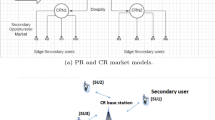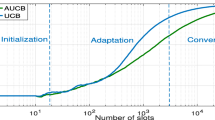Abstract
In the past decade, the OFDM access method has been widely used in different types of networks. Indeed; OFDM is the technology of choice for all major wireless systems, including WIFI, WiMAX, 3G, 4G and 5G. In this paper, we are interested in its application within a cognitive radio networks. The main objective is to provide an acceptable quality of service for the secondary user while minimizing interference with the primary user. This problem has been formulated in the literature in the form of a multi-objective function with three modes of communication (multimedia, reliable and low battery). In this paper, we exploit the efficiency of the bounding operators of the branch and bound method in order to solve this problem. The simulation results showed the effectiveness of our proposal by comparing it with the cuckoo search algorithm which has already been validated in the literature for this type of problem. Our proposal surpasses the cuckoo search algorithm for two modes of communication in terms of fitness and execution time.






Similar content being viewed by others
References
Hosseinzadeh Aghdam, M., & Sharifi, A. A. (2021). A novel ant colony optimization algorithm for PAPR reduction of OFDM signals. International Journal of Communication Systems, 34(1), e4648.
Patel, V., & Warhade, K. (2021). An Improved Carrier Frequency Offset Estimation Under Narrowband Interference in OFDM Cognitive Radio. Advances in Signal and Data Processing (pp. 531–544).
El Bahi, F. Z., Ghennioui, H., & Zouak, M. (2019). Spectrum sensing technique of OFDM signal under noise uncertainty based on Mean Ambiguity Function for Cognitive Radio. Physical Communication, 33, 142–150.
Kumar, M., & Majhi, S. (2019). Joint signal detection and synchronization for OFDM based cognitive radio networks and its implementation. Wireless Networks, 25(2), 699–712.
Meylani, L., Kurniawan, A., & Arifianto, M. S. (2019). Radio resource allocation with the fairness metric for low density signature OFDM in underlay cognitive radio networks. Sensors, 19(8), 1921.
Thangaraj, C. A., & Aruna, T. (2019). Energy-efficient power allocation with guaranteed QoS under imperfect sensing for OFDM-based heterogeneous cognitive radio networks. Wireless Personal Communications, 109(3), 1845–1862.
Shah, H. A., & Koo, I. (2018). A novel physical layer security scheme in OFDM-based cognitive radio networks. IEEE Access, 6, 29486–29498.
Varade, P., Wabale, A., Yerram, R., & Jaiswal, R. (2018). Throughput Maximization of Cognitive Radio Multi Relay Network with Interference Management (2088–8708). International Journal of Electrical & Computer Engineering, 8(4), 2230–2238.
Saoucha, N. A., & Benmammar, B. (2019). Bio-inspired approaches for OFDM-based cognitive radio. International Journal of Internet Protocol Technology, 12(2), 61–75.
Tuan, P. V., Viet, P., & Koo, I. (2016). Throughput maximisation by optimising detection thresholds in full-duplex cognitive radio networks. IET Communications, 10(11), 1355–1364.
Benmammar, B., Benmouna, Y., & Krief, F. (2019). A Pareto optimal multi-objective optimisation for parallel dynamic programming algorithm applied in cognitive radio ad hoc networks. International Journal of Computer Applications in Technology, 59(2), 152–164.
Benmammar, B., et al. (2017). A parallel implementation on a multi-core architecture of a dynamic programming algorithm applied in cognitive radio ad hoc networks. International Journal of Communication Networks and Information Security, 9(2), 196.
Benmouna, Y., Benazzouz, M., Chikh, M. A., & Mahmoudi, S. (2019). New Method for Bayesian Network Learning. International Journal of Pattern Recognition and Artificial Intelligence, 33(2), 1959005.
Benmouna, Y., Mezmaz, M. S., Mahmoudi, S., & Chikh, M. A. (2020). Parallel cycle-based branch-and-bound method for Bayesian network learning. Pattern Analysis and Applications, 23, 897–911.
Saoucha, N. A., & Benmammar, B. (2017). Adapting radio resources in multicarrier cognitive radio using discrete firefly approach. International Journal of Wireless and Mobile Computing, 13(1), 39–44.
Newman, T. R., Barker, B. A., Wyglinski, A. M., Agah, A., Evans, J. B., & Minden, G. J. (2007). Cognitive engine implementation for wireless multicarrier transceivers. Wireless Communications and Mobile Computing, 7(9), 1129–42.
Yang, X. S., & Deb, S. (2017). Cuckoo search: state-of-the-art and opportunities. In 2017 IEEE 4th international conference on soft computing & machine intelligence (ISCMI) (pp. 55–59). IEEE.
Darwin, C. (1859). On the origin of species by means of natural selection, or, the preservation of favoured races in the struggle for life. J. Murray.
Kennedy, J., & Eberhart, R. C. Particle Swarm Optimization . In Proceedings of the IEEE international conference on neural networks IV (pp. 1942–1948), Perth, Australia, November (1995).
Tilahun, S. L., & Ngnotchouye, J. M. T. (2017). Firefly algorithm for discrete optimization problems: A survey. KSCE Journal of Civil Engineering, 21(2), 535–545.
Yang, X. S. (2010). A new metaheuristic bat-inspired algorithm. In Nature inspired cooperative strategies for optimization (NICSO 2010) (pp. 65–74). Springer, Berlin, Heidelberg.
Kingsbury, N. (2020) Approximation Formulae for the Gaussian Error Integral, Q(x). http://cnx.org/content/m11067/latest/. Accessed January (2020).
Newman, T. R. (2008). Multiple objective fitness functions for cognitive radio adaptation (Doctoral dissertation, University of Kansas).
Author information
Authors and Affiliations
Corresponding author
Additional information
Publisher's Note
Springer Nature remains neutral with regard to jurisdictional claims in published maps and institutional affiliations.
Rights and permissions
About this article
Cite this article
Benmouna, Y., Benmammar, B. Interference-Aware QoS Guarantees in OFDM-Based Cognitive Radio Networks Based on Branch and Bound. Wireless Pers Commun 120, 169–183 (2021). https://doi.org/10.1007/s11277-021-08440-0
Accepted:
Published:
Issue Date:
DOI: https://doi.org/10.1007/s11277-021-08440-0




